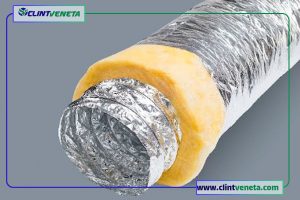Flexible duct with elastomeric insulation
Insulation and ducting of air ducts, especially in today’s low-rise false ceilings, has become a challenge that greatly limits the possibility of operation. The use of flexible ducts with elastomeric insulation has been able to solve this problem to a large extent.
Flexible duct with elastomeric insulation or hose duct with elastomeric insulation is considered as one of the best tools for air transfer these days. This channel is used in many air conditioning systems and plays a very important role in this industry.
Flexible duct structure with elastomeric insulation

This type of channel, as its name implies, is completely flexible and consists of three layers, as follows:
- First layer (inner): Aluminum foil is laminated
- Second layer (middle): elastomeric compact insulation as thermal and acoustic insulation in 2 layers with a thickness of 3mm in the form of overlap along the channel branch
- Third layer (exterior): The protective cover is made of laminated aluminum
Flexible duct with elastomeric insulation is a type of thermal and cryogenic insulation. These channels are directly found in pipes and rolls in different sizes and thicknesses in the market, which you can see in the Clintveneta products page and contact us to buy any of them. This insulation is better than wool and glass insulation due to its fire resistance percentage and has been used more in the installation industry. Other features of this insulation include high resistance to pollution and moisture, which prevents the growth of disease and fungal bacteria, and even if part of it is damaged, it exists as it does against bacteria and fungi.
Comparison of these channels with ordinary flexible insulation
This type of channel, in addition to the structure mentioned in the above paragraphs, is laminated and reinforced with steel springs.
In a conventional flexible duct, the inner tube is connected to the main air duct during the installation process by gluing. After this step, the cover that was opened to the back is installed on the inner pipe and then the installation work is completed using fasteners and glue. But in a flexible duct with elastomeric insulation, the installation process ends with only one step. This feature saves time and money, which is very valuable.
The outer diameter of this type of flexible duct is smaller than the normal type and as a result they take up less space. This feature also makes them easier to transport.
In conventional flexible ducts, air is created between the cover and their insulation material, which is usually fiberglass, if any holes or tears occur during installation. This causes the dust to penetrate and over time causes it to decay and deteriorate. The same thing happens with fiberglass insulation, which also causes allergies. However, in a flexible duct with elastomeric insulation, due to its complete lamination, holes and possible ruptures in the area are limited and no air flow is created. For this reason, there is no problem in the structure of the canal and it does not cause allergies.
Due to the use of elastomeric insulation in this type of ducts, they can be used as a sound insulation without effort and cost. However, in conventional flexible ducts, sound insulation is very laborious and expensive.
Features of flexible duct with elastomeric insulation
- Quick and easy repair and installation and no need for additional coverage
- Prevents the absorption and penetration of moisture
- Lightness and high flexibility
- Long service life
- No dust in the environment
- Connected and uniform structure throughout the channel
- Insulation proportional to very low heat transfer coefficient
- Suitable in the temperature range of +110 to -30 ° C
- Prevents the transmission of airflow along flex channels due to high compression
You can choose the flexible duct with elastomeric insulation in your desired model and thickness from Clintveneta store and contact us to buy or get more information.